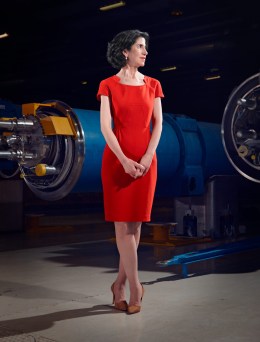
The LHC, where Gianotti now works and the Higgs discovery was made, straddles the French-Swiss border and is the foremost collider in the world, with a 16.7-mile (27 km) circumference. The machine and its accomplishments are the result of a quarter-century of effort by a worldwide community of scientists. All that effort and hardware is devoted principally to accelerating protons to near the speed of light, then crashing them together at enormously high energies. In the subatomic debris that results from these collisions, the Higgs and other secrets of the universe might be found.
Here’s why the Higgs in particular is so important: a particle doesn’t necessarily have to have mass; the photon, the basic quantum of light, doesn’t. If no particles had mass, however, the universe, along with everything in it, would be a decidedly different (and decidedly less solid) place. “The Higgs particle has two functions,” says Gianotti. “One is to give mass; the other is to allow the standard model to behave properly up to the highest energies.”
(MORE: The Cathedral of Science: How the Higgs Was Found)
The Higgs theory — named for British physicist Peter Higgs, one of its leading developers — states that particles live in a field with which they interact. Those interactions give particles their mass, basically by attracting Higgs bosons to them. The more they attract, the greater their mass.
The team Gianotti leads at the LHC does its work with an instrument known as the ATLAS detector, which is 151 ft. (46 m) long and 82 ft. (25 m) high and is equipped with a massive magnet system that allows the paths of charged particles to be bent so they can be measured. Gianotti’s work involves running the experiment at all levels — defining the overall scientific strategy, supervising the day-by-day progress of the experiment and the operation of the 7,000-ton machine and dealing with the unavoidable budgeting and human issues that come with overseeing so considerable a project.
That’s the big picture. The smaller picture is a more elegant one, and it’s where Gianotti’s artistic history shows. She made particularly important contributions to a piece of hardware known as the liquid-argon calorimeter, which detects electromagnetic energy. It has a beautiful geometry that allows it to respond in less than 50 billionths of a second, so energy from particles moving close to the speed of light can be detected.
It’s a quirk of CERN that team leaders like Gianotti — with their power over so many people and so much machinery — do not have titles like chief scientist or project director. They are simply called spokespeople, which says something about the deeply collaborative nature of the work and also helps explain why Gianotti takes more than the ordinary care to deflect and share credit for the Higgs triumph. “It’s not only a great scientific endeavor but a unique human adventure,” she says. “Working with so many people from all over the world is extremely enriching and stimulating.”
With the Higgs particle in hand, Gianotti and her team have a lot more questions to answer. Does the particle have the precise properties they expected, or does it differ ever so slightly? In the world of particle physics, that would have more than slight implications for how it operates. The discovery of the boson could also lead to insights into some of physics’ other great mysteries, like matter-antimatter asymmetry: essentially, why is there more of one — matter — when the two should be equal?
Gianotti is also dealing with the special burdens — and joys — that come with being a role model. She receives all manner of mail these days, often from high school students and, yes, often from girls, who are inspired by the way she has risen and thrived. But the story she likes to tell involves a young man, an undergraduate physics student in Italy who was ready to abandon his studies because he thought the future of the field was too grim. He stumbled across a magazine interview with her, hunted down her e-mail address and wrote her to say she had given him new hope, new resolve. “I called him and we had several chats, and I encouraged him strongly to continue,” Gianotti says. “I told him, ‘Never abandon your dreams. You may regret it for the rest of your life.’”
The young physicist took her advice, switched to particle physics and, as things would have it, wound up at CERN, in the LHC, working on the ATLAS experiment. He owes his boss — O.K., his spokesperson — more than a good day’s work. He owes her thanks for the wisdom that got him this far.

